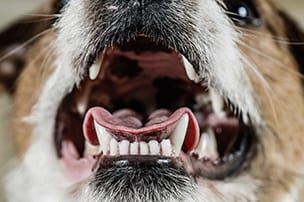Dog & Cat Teeth Cleaning in Palos Heights
Did you know that more than 50% of all dogs and cats have some form of gum disease by just 3 years of age? Gum disease is an infection that begins with dental plaque, which can result in bad breath, pain, gum irritation, and tooth loss. If left untreated, gum disease can even lead to liver, heart, and kidney disease. The good news is that with regular professional dog and cat teeth cleanings and at-home care, you can prevent gum disease for your pet. We generally recommend that all pets have a dental exam and cleaning once every one to three years.
Palos Animal Hospital wants to help you be proactive about your pet’s oral health, which is why we offer a wide variety of dental services, including surgery. In accordance with AAHA’s guidelines for pet dentistry, we use only the latest and safest tools and technology for our dental services. Our certified veterinary technicians use state-of-the-art monitoring equipment to monitor your pet’s vitals before, during, and after their dental procedure. For your pet’s comfort, we offer heated tables and can provide each patient with a complimentary, stress-free nail trim as a courtesy during the dental procedure.
We offer dental promotions every January, March and September, so be sure to check out our Promotions page for details and updates!
Dog & Cat Teeth Cleaning Steps
Step 1: Pre-anesthetic Blood Screening: We recommend pre-anesthetic bloodwork for all pets undergoing an anesthetic procedure. It’s also required for pets age 3 and older. The blood test determines if your pet is healthy enough for anesthesia. Occasionally, a pre-anesthetic ECG is recommended as well to check for abnormal heart rhythms.

Step 2: IV Catheter Placement: Most pets are given an IV catheter so they can be given fluids during their teeth cleaning. IV fluids correct any underlying dehydration and help maintain good blood pressure.
Step 3: Teeth Cleaning and Polishing: Tartar and plaque are cleaned off using an ultrasonic scaler by our certified veterinary technicians, with a veterinarian on-hand at all times. Teeth are then polished to remove any rough spots that could increase the likelihood of plaque formation.
Step 4: Oral Examination/Charting: Once the teeth are clean, each tooth is checked for mobility, fractures, infection, gum disease, and cavities. The gum tissue, lips, roof of the mouth, and tongue are also checked for injuries, infection, and tumors. If needed, dental X-rays are taken to evaluate the health of tooth roots, pulp, and bone around the tooth.
Step 5: Treatment of Gum Disease (if necessary): If your pet has gum disease, we apply fluoride foam to the teeth for a minute or two before rinsing the mouth. If there are broken, loose, or infected teeth, our veterinarian surgically removes them to eliminate the source of infection and any accompanying pain. Antibiotics and pain medication are sent home for a short time after oral surgery to keep your pet comfortable during the healing process.

At-Home Pet Dental Care
At-home pet dental care is another important part of maintaining your pet’s dental health and preventing dental disease. Brushing your pet’s teeth daily using a soft toothbrush and flavored pet toothpaste can help slow the formation of calculus. Certain chew toys and specially formulated diets can help prevent plaque buildup as well. We recommend that you use only dental products that are approved by The Veterinary Oral Health Council (VOHC).
A healthy mouth is a happy mouth, so call Palos Animal Hospital today if you have any questions about dental care for your pet or if you’d like to schedule an appointment.




